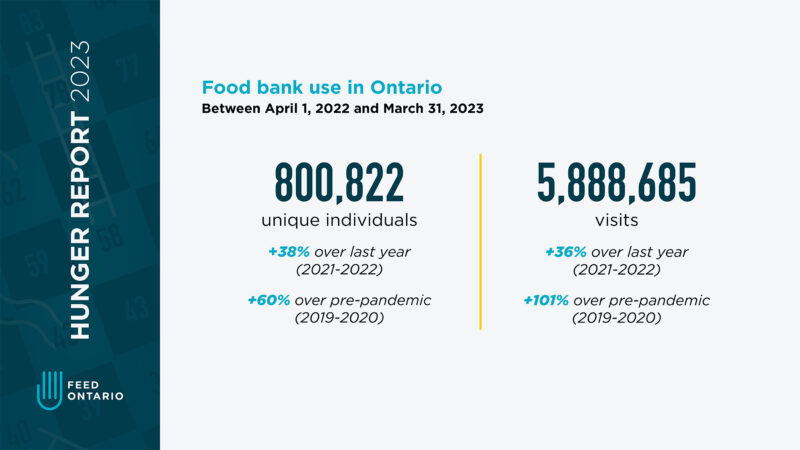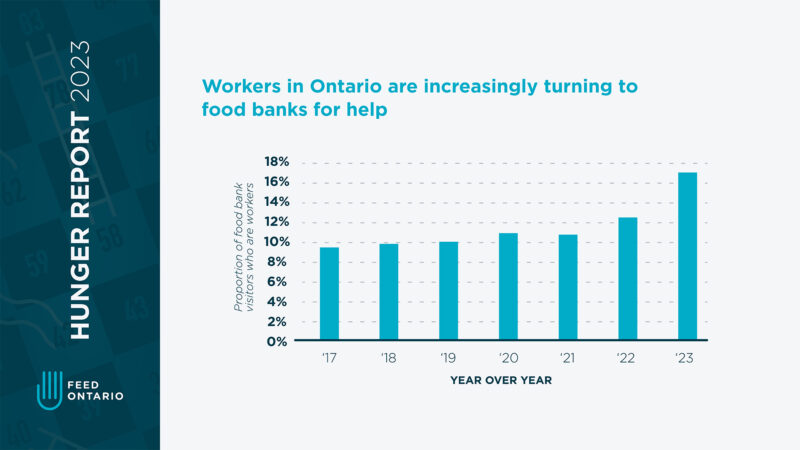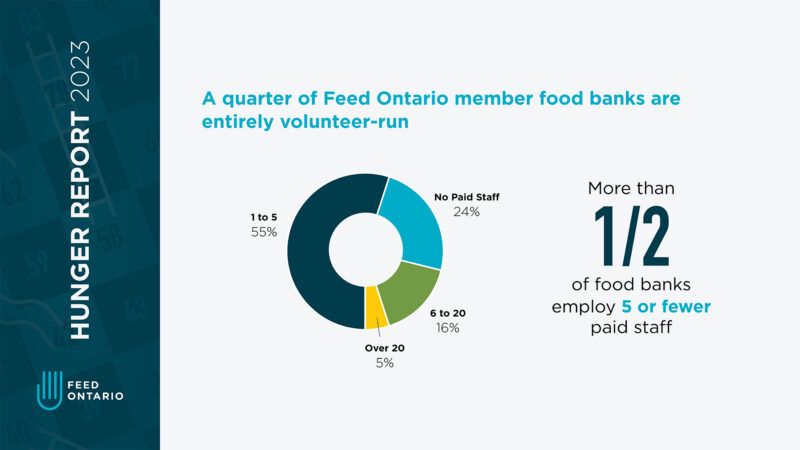November 27, 2023 (Toronto, ON) – Feed Ontario released its 2023 Hunger Report today, revealing that over 800,000 people accessed emergency food support last year, visiting more than 5.9 million times. This is an increase of 38 per cent and 36 per cent respectively over the previous year, and the largest single-year increase ever recorded by Ontario’s food bank network. A major driver of this extraordinary growth came from people who had never had to rely on a food bank before, with 2 in 5 people being first-time visitors, a 41 per cent increase over the previous year.
The report highlights that food bank use has been increasing for the last seven consecutive years and points to the progressive growth of precarious work, an erosion of our social support programs, and a failure to invest in affordable and supportive housing as the longstanding drivers. More recently, the spiralling cost of living crisis has made it even more difficult for people in Ontario to stretch their already stretched income any further to afford their basic necessities.
“Ontarians are struggling to get ahead,” said Carolyn Stewart, CEO at Feed Ontario. “While we are seeing low unemployment rates across the province, working Ontarians are having trouble earning enough income to afford today’s cost of living. As a result, more people than ever before are turning to food banks for help.”
In 2022, the unemployment rate in Ontario returned to pre-pandemic levels, yet food bank use has continued to rise. As detailed in the report, workers are turning to food banks in ever-greater numbers, with more than one in six visitors citing employment as their primary source of income. Precarious work is a major driver of this trend, as Ontario’s labour market has shifted, with temporary and part-time jobs comprising a greater share of the labour force. As a result, earnings are not increasing as fast as expenses, making it difficult for Ontarians to make ends meet.
“It used to be that having a job meant that you would not need to access a food bank,” says Stewart. “This is no longer the case. Working Ontarians are having trouble earning enough income to afford today’s cost of living, even when working multiple jobs or trying to cut expenses.”
Beyond the newer trends concerning working Ontarians, inadequate social assistance programs continue to be a longstanding driver of food bank use. As detailed in the report, monthly incomes for social assistance recipients remain more than $1,300 below the poverty line. These low rates both put people in poverty and make it harder to move out of poverty.
Inadequate incomes are only one part of the story. The lack of affordable housing continues to be a significant driver of food bank use as more Ontarians are faced with housing costs that require the majority of, or even exceed, their monthly income. As revealed in the report, two thirds of food bank visitors have less than $100 left each month after paying for housing.
“As a fixed expense, unaffordable housing drives food insecurity and food bank use as it makes it difficult, if not impossible, to afford any other necessities,” said Stewart. “Essential items like heat, hydro, medicine, and food become unobtainable when a person cannot keep a roof over their head.”
In addition to the challenges being faced by Ontarians, the report discusses the challenges being faced by food banks as they struggle to meet this surge in demand. Primarily it notes that food banks were designed to respond in emergency situations, providing support for a short period of time to help get people back on their feet. They were never intended to be a long-term solution or to fill the gaps created by income insecurity and decreased affordability.
“Food banks are continuing to work incredibly hard, but they are struggling to keep up,” said Stewart. “We are hearing from food banks daily that they are concerned about keeping their doors open, let alone keeping supplies on their shelves.”
Food banks are not immune to the financial challenges being faced by Ontarians. As the need in Ontario communities continues to grow, it is outpacing the available food and financial resources that food banks rely on to provide service. As a result, more food banks are having to make the difficult decision to reduce service, and some are even worried that they will have to shut down completely.
When it comes to addressing this crisis, the report is clear: food banks are not a solution to food insecurity or poverty; only good public policies that ensure adequate access to income and affordability are able to create meaningful change. The report calls on the Government of Ontario to help Ontarians get ahead by improving Ontario’s social assistance programs by increasing rates and reducing clawbacks, investing in affordable and supportive housing, and supporting working Ontarians through the development of quality jobs and improvements to labour laws.
“Poverty is a policy choice, and our government has the ability to make meaningful change,” said Stewart. “We cannot let this record-high food bank use become the new normal and we cannot let hunger in Ontario become normal.”
2023 Hunger Report Highlights and Trends

Food bank use data
Food bank use remains at an all-time high with this year marking the seventh consecutive year of food bank use increases.
- 800,822 adults and children accessed a food bank in Ontario between April 1, 2022, and March 31, 2023 – an increase of 38% over last year and 60% over pre-pandemic levels.
- Ontario’s food banks were visited 5,888,685 times throughout the year, an increase of 36% over last year and 101% over pre-pandemic levels.
Drivers of food bank use
In addition to unprecedented inflation rates and the rise in the cost of living, there are several longstanding income insecurity issues and poor public policies that have contributed to the rise in food bank use:
Precarious employment
- More than 1 in 6 food bank visitors cited employment as their primary source of income, an 82% increase over 2016-17 and a 37% increase over the previous year.
- People working a contract or seasonal position are four times more likely to rely on a food bank than all Ontario workers and those working part-time jobs are three times more likely.

Legislated Poverty
- Social assistance remains the primary source of income for the majority of food bank visitors with 26% relying on OW and 28% relying on ODSP.
- The number of people relying on ODSP and OW has increased 17% over the previous year.
Housing and Cost of Living
- 71% of food bank survey respondents acknowledged their circumstances are worse or much worse than prior to the pandemic, attributing their circumstances to the rising cost of living including housing, food, transportation, and other essentials.
- 22% of food bank visitors have housing costs that exceed their monthly income.
- 34% of food bank survey respondents rarely or never have someone to depend on when they need it.
Trends in food banking
- 1 in 19 Ontarians relied on a food bank, a 41% increase over 2019-2020.
- 2 in 5 people visiting a food bank are doing so for the first time, a 41% increase over the previous year.
- Those relying on a food bank who visited 1-3 times a year decreased by 6% while those who visited 13 or more times per year increased by 38%.
- 1 in 4 food banks experienced a growth of 40% or greater in unique visitors.

Food Bank Service Models
- 84% of food banks provide programming and services beyond emergency food support including income tax preparation, community kitchens, thrift stores, emergency shelters or rent support, public health services, community referrals, and more.
- 23% of food banks in the Feed Ontario network are volunteer run and nearly 80% have five or fewer paid staff.
- 1 in 7 food banks purchased more than 20% of the food they distribute to visitors.
- 1 in 3 food banks have increased the volume of food purchasing by 90% or more over the last three years.
Food Bank Sustainability
- 69% of food banks are concerned about having enough food and 53% indicate they are worried they do not have enough funding to adequately meet demand in their community.
- With demand exceeding capacity and resource limitations, 24% of food banks are concerned they will need to pause or reduce service.
- 4% of food banks are worried they may need to close their food bank completely within the next six months due to insufficient resources.
To download a full copy of the 2023 Hunger Report, or to find out more about food banks in Ontario, please visit: https://www.feedontario.ca/hunger-report-2023.
Fork in the Road – Online Tool
Alongside the 2023 Hunger Report, Feed Ontario has launched its new online platform ‘Fork in the Road’. This interactive tool guides users through some of the tough decisions that Ontarians living on a low income face each month as well as the systematic forces that trap them in poverty. Can you make it through the month? Visit: www.feedontario.ca/fork-in-the-road.
